Last Updated on May 23, 2025 by Kittredge Cherry
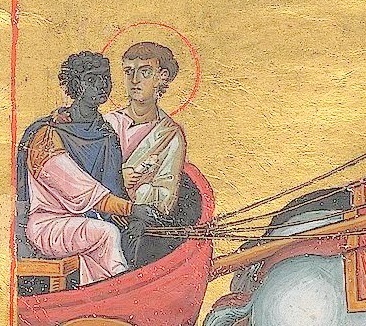
A queer black man was welcomed as an early Christian convert in Biblical times, according to progressive Bible scholars. He was a triple outsider — a gender-variant foreigner from a racial minority — and his story shows that the early Christians welcomed all kinds of outcasts.
His experiences may have led him to the Bible prophecies about the “suffering servant,” which he was reading when Philip met him. The term translated as “eunuch” included a variety of sexual minorities that today might be called queer or LGBT.
The Ethiopian eunuch is widely revered in Protestant, Catholic and Orthodox traditions under many different names on a variety of dates. The Episcopal church voted to add Simeon Bachos the Ethiopian Eunuch to its calendar of saints starting in 2022 with a feast day of Aug. 27.
The story of how the Ethiopian eunuch was converted and baptized by Philip the Evangelist is told in Acts 8:26-40. The scriptures about the Ethiopian eunuch will be read again in many churches on April 25, 2027.
Philip’s feast day on the Episcopal calendar is Oct. 11, which also happens to be National Coming Out Day. Philip could be considered a patron saint of LGBTQ allies.

Billboard by WouldJesusDiscriminate.org proclaims “The early church welcomed a gay man,” based on the Biblical story of the Ethiopian eunuch
In the Bible the Ethiopian eunuch is nameless, resulting in an astonishing array of distinct names bestowed by different traditions to fill the void. Second-century saint Irenaeus wrote about him as Simeon Bachos the Eunuch and said that he was sent to Ethiopia to preach. In African tradition his name is known as Qinaqis. Greek and Russian Orthodox calendars refer to him as Aetius. He is also named Djan Darada (Джан Дарада) in some Russian sources. In Eastern Orthodox tradition he is considered to be “Simeon the Black” or “Simeon who was called Niger” in Acts 13:1. The Ethiopian Orthodox Tewahedo tradition refers to him as Bachos.
The New Testament story of the Ethiopian eunuch echoes the much earlier account of another Ethiopian eunuch: Ebed-Melech, who rescues the prophet Jeremiah in the Hebrew scriptures (Jeremiah 38).
The Ethiopian eunuch has become a favorite among LGBTQ theologians and people of faith. He is portrayed in genderbending performances by Bible scholar/actor Peterson Toscano and examined in many books with titles such as “Unmanly Men” and “Queering the Ethiopian Eunuch.”
New in 2024: A long tradition of holy eunuchs
The Ethiopian eunuch is part of a proud tradition of eunuchs in Biblical and church history. There were many eunuchs in the Hebrew scriptures, such as Ashpenaz, who gave “favor and tender love” to the prophet Daniel, and Hegai from the story of Esther.
The Ethiopian eunuch was the first in a long line of eunuchs who were recognized by the Catholic and/or Orthodox traditions as Christian saints, martyrs or partners of saints. They include saints Protus and Hyacinth, third-century eunuch martyrs from Egypt; Chrysaphius, who was the beloved of Theodosius II, a Roman emperor and Orthodox saint; fourth-century martyr Indes the Eunuch; fourth-century Persian saint Chusdazat; venerable Cosmas the eunuch from sixth-century Palestine, and saint Ignatius of Constantinople, who became Ecumenical Patriarch of Constantinople, the highest position in the Eastern Orthodox church, in the ninth century. Third-century Christian scholar Origen of Alexandria is said to have castrated himself.
A historical source on this is the Treatise in Defense of Eunuchs, written in Greek in the 12th century by Theophylact of Ochrid. In addition, some trans or cross-dressing saints also adopted identities as eunuchs when they became monks or hermits.
Why is the Ethiopian eunuch considered queer?
In contemporary usage a “eunuch” is a castrated man, but it had a broader definition in ancient times. Biblical eunuchs can stand for all sexual minorities. Literally meaning “the keepers of the bed,” the eunuchs served and guarded the women in royal palaces and wealthy households. Their employers wanted to be certain that the eunuchs would not get sexually involved with the women they were supposed to protect, so many eunuchs were castrated men, homosexual men, and intersex folk. Many, but not all, were both castrated and homosexual.
Eunuchs were highly trusted officials who often rose to senior posts in government during Biblical times. It’s a stark contrast with how homosexuals were considered security risks and fired from U.S. government jobs during the “Lavender Scare” of the mid-20th-century Cold War era. That was based on the idea that gays and lesbians were susceptible to blackmail because they led closeted double-lives, but eunuchs apparently lived openly as eunuchs in the Bible.

Billboard by WouldJesusDiscriminate.org references a scripture on eunuchs to affirm “Jesus said some are born gay”
Jesus himself used eunuch as an ancient term for LGBTQ people when he declared in Matthew 19:12: “There are eunuchs who were born that way, and there are eunuchs who have been made eunuchs by others–and there are those who choose to live like eunuchs for the sake of the dominion of heaven. The one who can accept this should accept it.” The traditional interpretation of this scripture is that Jesus was speaking of voluntary celibacy.
Bible tells Ethiopian eunuch’s story
Divine intervention plays a big role in the eunuch’s story from the start. It begins when an angel gives some surprising advice to Philip the Evangelist, also known as Philip the Deacon. He is not the apostle Philip who ministered directly with Jesus. This Philip was one of seven deacons who were chosen by the Christian community in Jerusalem and affirmed by the apostles.
Philip is in the midst of a successful evangelistic campaign in Samaria when the angel interrupts with an order to leave and take a lonely desert road through the wilderness from Jerusalem to Gaza.
On the road Philip meets a stranger in a chariot reading aloud from the Book of Isaiah on his way home from worshiping in Jerusalem. The man is described as an Ethiopian eunuch (“eunouchos” in Greek), an important official in charge of all the treasury of Candace, queen of the Ethiopians.
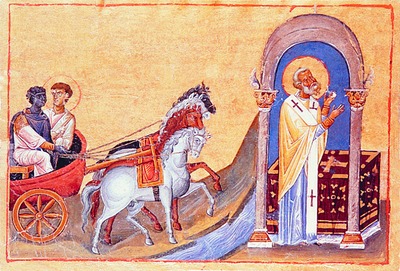
Philip and the Ethiopian Eunuch from the Menologion of Basil II, an 11th-century illuminated manuscript (Wikimedia Commons)
There is controversy over whether the Ethiopian eunuch was Gentile or Jewish. Church tradition assumes that he must have been a the first Gentile convert to Christianity because he was Ethiopian, but he could have been a Jewish convert.
When Philip sees the eunuch on the road to Gaza, the Holy Spirit again takes the initiative, urging him to run to join him in his chariot. Soon the two men are absorbed in conversation about the scripture that the eunuch was reading: Isaiah 53:7-8. The passage describes the humiliation and injustice experienced by God’s suffering servant.
The eunuch probably chose this scripture because he had just faced rejection from religious leaders when he worshiped at the temple in Jerusalem. Eunuchs were sexual outcasts in Jewish religious society, much like LGBTQ people in the church today. First-century Jewish law condemned homosexual acts and forbid converting eunuchs to Judaism. Deuteronomy 23:1 says bluntly, “No one whose testicles are crushed or whose penis is cut off shall be admitted to the assembly of God.”
Philip used the prophecy of God’s rejected servant to tell the eunuch about Jesus as they traveled together in the chariot. Maybe he pointed out Isaiah’s prophecy that comes a few chapters later:
As the chariot passes by some water, the eunuch raises a question that LGBTQ people today ask as well: “What can stand in the way of my being baptized?”
There was no reason to prevent the eunuch from receiving full membership rights in the church. Philip shows no concern about the eunuch’s gender identity, sexual orientation or race. Philip simply replies, “If you believe with all your heart, you may.” The the Bible specifies that both of them go down into the water. Philip baptizes the eunuch then and there.
“Philip and the Ethiopian Eunuch” by Queer Catholic Icons
Mission accomplished, the Holy Spirit suddenly takes Philip away. The men did not see each other again after that, but the Bible reports that the eunuch “went on his way rejoicing.”
The Bible notes that years later Philip and his four unmarried daughters received a visit from the Apostle Paul at their home in Caesarea.
Ethiopian eunuch in the arts
A rare artwork of Philip and the eunuch together in the water was inspired by a 2023 discussion in the LGBTQ Saints group. There’s nothing like this because it shows the intimate moment of baptism in the river… without hiding the gender-variant nature of the eunuch. Unlike most images of the pair, they BOTH have halos. Matthew of Queer Catholic Icons explains:
“This was inspired by something @kittredgecherry posted on Facebook, about the baptism of the Ethiopian eunuch as portrayed in Acts being both a sign of the Church’s welcome of all, and a moment of joy. I wanted to make an attempt at portraying that joy, and the queer tenderness between a man and a gender variant person in the moment of the latter’s baptism. In that sense, it becomes a double sacrament: the physical sacrament of a baptism in water, and the more metaphysical sacrament of intimacy between persons (a sacrament queer folks know well).”
Tobias Haller was inspired to create an icon of Simeon Bachos when the Episcopal voted to add him to its calendar of saints in 2022. He created a beautiful effect with the black paper showing through to become the color of his skin. Haller shows Simeon wearing a pearl earring, an oblique reference to the pearl of great price in Matthew 13:45-46. “There’s something about the impetuousness with which he leaps into baptism that reminds me of the merchant who sold everything he had in order to get that precious pearl,” Haller told Q Spirit. He is an iconographer, author, composer, and retired vicar of Saint James Episcopal Church in the Bronx, still assisting at a parish in Baltimore, Maryland. Haller and his spouse were united in a church wedding more than 30 years ago and a civil ceremony after same-sex marriage became legal in New York.
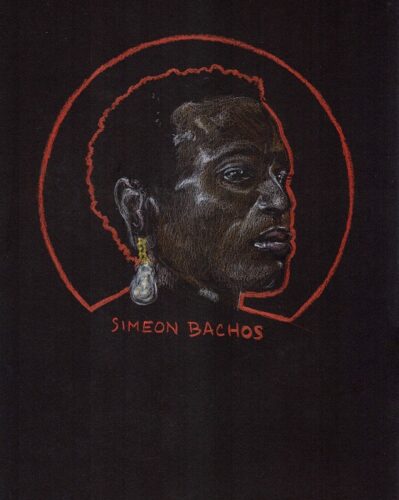
Simeon Bachos the Ethiopian eunuch by Tobias Haller
The Ethiopian eunuch has a halo with the rainbow colors of the LGBTQ community in a 2020 portrait by North Carolina artist Jeremy Whitner. Most depictions of the Ethiopian eunuch focus on the baptism and colonization imagery, but Whitner said he felt inspired to show what has been missing: “depictions of him reading the scriptures by himself. And the personhood of him.” Whitner is a gay Christian mystic in process for ministry with the Disciples of Christ.
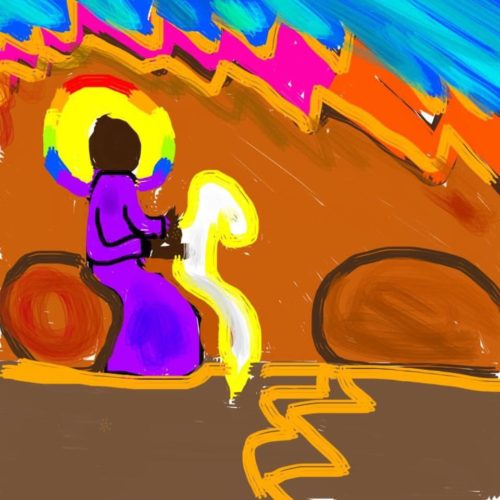
“Ethiopian Eunuch” by Jeremy Whitner
Over the centuries many visual artists, including Rembrandt, have painted the Ethiopian eunuch’s conversion and baptism. The image of of Philip and the Ethiopian eunuch at the top of this post is from the Menologion of Basil II, an 11th-century Byzantine illuminated calendar manuscript now in the Vatican library. It presents a beautiful image of harmony between men of different races and sexual orientations. Unfortunately a lot of other historical paintings of the Ethiopian eunuch have an undertone of racism, showing the Ethiopian as exotic or childlike.
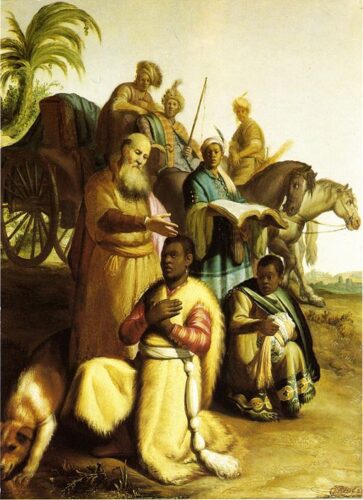
“The Baptism of the Eunuch” by Rembrandt, 1626 (Wikimedia Commons)
A modern Expressionist painting of the Ethiopian eunuch was done by renowned Austrian artist Herbert Boeckl. It is part of a monumental series of frescoes showing the Apocalypse in the Angel Chapel of Seckau Abbe in Styria, Austria. He worked on the frescoes from 1952 to 1960.
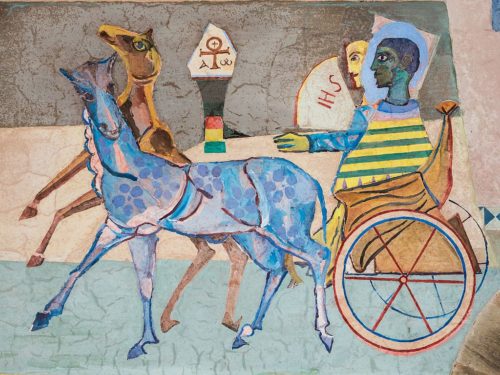
Philip and the Ethiopian Eunuch in a fresco of the Apocalypse by Herbert Boeckl (Wikimedia Commons)
 Biblical eunuchs are boldly interpreted by Peterson Toscano, an actor and Bible scholar who identifies as a “quirky, queer Quaker.” He discusses the Ethiopian eunuch on his website. Toscano metamorphoses into an impressive array of eunuchs and other gender-nonconforming Biblical figures in a one-person performance called “Transfigurations: Transgressing Gender in the Bible.” Toscano backs up each monologue with an enjoyable mini-lecture on the Biblical scholarship behind it. The show received high praise when it toured seminaries and LGBTQ events across the United States and Europe. It is available for streaming at Amazon.com and on DVD from Barclay Press.
Biblical eunuchs are boldly interpreted by Peterson Toscano, an actor and Bible scholar who identifies as a “quirky, queer Quaker.” He discusses the Ethiopian eunuch on his website. Toscano metamorphoses into an impressive array of eunuchs and other gender-nonconforming Biblical figures in a one-person performance called “Transfigurations: Transgressing Gender in the Bible.” Toscano backs up each monologue with an enjoyable mini-lecture on the Biblical scholarship behind it. The show received high praise when it toured seminaries and LGBTQ events across the United States and Europe. It is available for streaming at Amazon.com and on DVD from Barclay Press.
Philip, the deacon in the story, is often confused with the apostle Philip whose feast day falls on May 1 or May 3. However St. Philip the Deacon (sometimes called Protodeacon) is honored on Oct. 11 in the Catholic and Episcopal churches and on June 6 in the Orthodox Church. Whatever the day, his example of unlimited welcome for a queer black man is an inspiration for today.
Books related to the Ethiopian eunuch
Pioneering African American gay church leader and professor James Tinney delivered a landmark sermon titled “ ‘What Doth Hinder Me?’ The Conversion of a Black Homosexual as Recorded by St. Luke” at Metropolitan Church of Philadelphia, Nov. 15, 1981. In the sermon, he provided a gay-friendly interpretation of the Ethiopian eunuch who was baptized by Philip. Tinney claimed that “eunuchs in the Ancient Near Eastern world were at least disposed toward homosexuality, if not practicing homosexuals.” The sermon is included in the 1985 book “Good News for Modern Gays: A Pro-Gay Biblical Approach” by Sylvia Pennington.
Many other authors explore the implications of the Ethiopian eunuch for LGBTQ people today in books such as:
Queering the Ethiopian Eunuch: Strategies of Ambiguity in Acts by Sean D. Burke
“Byzantine Intersectionality: Sexuality, Gender, and Race in the Middle Ages” by Roland Betancourt. Includes a chapter on the Ethiopian eunuch. Published by Princeton University Press in 2020.
A rare and important parallel with another Biblical Ethiopian eunuch is explored in “OtherWise Christian: A Guidebook for Transgender Liberation” by Chris Paige. The chapter “Two Ethiopian Eunuchs” connects the eunuch converted by Philip with Ebed-melech, the Ethiopian eunuch who rescued the prophet Jeremiah from dying in a well in Jeremiah 38:1-13.
Paige is also editing the forthcoming book “OtherWise Christian 3: What Shall Prevent Me?” It aims to build a multi-vocal discussion around the story of the Ethiopian eunuch, exploring issues of gender, race, land and body sovereignty and much more.
The story of the Ethiopian eunuch is re-imagined through a queer lens in the 1990s Midwest with “Queering My Religion: Biblical Stories of Queer Love in the ‘90s” by Jeff Crim. It was independently published in 2023. Based in Tennessee, the author is an ordained minister in the Evangelical Lutheran Church.
Unmanly Men: Refigurations of Masculinity in Luke-Acts by Brittany E. Wilson Includes a chapter on the Ethiopian eunuch
“Sex Difference in Christian Theology: Male, Female, and Intersex in the Image of God” by Megan K. DeFranza.
The Children Are Free: Reexamining the Biblical Evidence on Same-sex Relationships by Jeff Miner and John Tyler Connoley
Jesus, the Bible, and Homosexuality, Revised and Expanded Edition: Explode the Myths, Heal the Church by Jack Rogers
The Man Jesus Loved: Homoerotic Narratives from the New Testament by Theodore Jennings
Outing the Bible: Queer Folks, God, Jesus, and the Christian Scriptures by Nancy Wilson
Freedom, Glorious Freedom: The Spiritual Journey to the Fullness of Life for Gays, Lesbians, and Everybody Else by John McNeill
The Queer Bible Commentary by Deryn Guest, Robert E. Goss, Mona West and Thomas Bohache
A literary look at the life of a gay eunuch in Biblical times is provided in “The Persian Boy,” a historical novel by Mary Renault.
Salvatore Sapienza discusses the LGBTQ-affirming message of the Ethiopian Eunuch in a 2021 sermon-excerpt video. He is author of “Gay is a Gift” and pastor of Douglas United Church of Christ in Saugatuck/Douglas, Michigan.
Hymns sing about the Ethiopian eunuch
A variety of hymns have been written about the Ethiopian eunuch over the years. For example, “Lift Every Voice and Sing II: An African American Hymnal” includes “The Angel Said to Philip,” which was written in 1992 by Harold T. Lewis. It is sung on video by the St. James Virtual Choir from St. James Episcopal Church in Newport Beach, California. Unfortunately it does not include the word “eunuch,” referencing only the “Ethiope.”
Many of the older hymns do sing specifically about the eunuch, by they are marred by racism and “worm theology” that sees expressions of low self-esteem as a way to glorify God. Some lines do still resonate today, such as this question raised in a 1787 hymn by Benjamin Beddome:
The holy eunuch, when baptiz’d,
Went on his way with joy:
And who can tell what rapturous thoughts,
Did then his mind employ?
Two recent hymns with progressive sensibilities about the Ethiopian eunuch were written by Daniel Charles Damon, an internationally published writer of hymns and pastor of First United Methodist Church in Richmond, California.
His hymn “A Eunuch Worships God” was released in 2020 by Hope Publishing. It begins:
A eunuch worships God,
He read the ancient Word,
And heading home, he asks for help
From one who overheard…
In 2022 he was inspired to write second hymn, “A Eunuch, Trusted by my Queen,” when a student at Vanderbilt University Divinity School challenged him to “Write a hymn in the voice of the eunuch.” He imagined how the eunuch felt in lyrics such as these:
A eunuch may not go inside
this place of prayer and praise,
but as I am and where I am,
my heart’s cry I must raise.
Excluded by the human law–
unjust, unfair, and wrong–
I lift my prayer, I worship God,
I raise an angry song.
What hurt is done to me by this?
What hurt is done to you?
You do not even know my name,
yet dare call me taboo!
Ethiopian eunuch prayers
Q Spirit’s Litany of Queer Saints includes this line:
“Simeon Bachos the Ethiopian eunuch, who was welcomed by the early church as part of God’s creative diversity, pray for us!”
The official Episcopal collect (prayer) for the feast of Simon Bachos includes this line:
“Give us the grace to follow where you lead, overcoming the barriers that divide and diminish your people.”
Links related to the Ethiopian eunuch
Bringing the whole Black self: Biblical eunuchs and intersex identity by Rana Irby (blackcatholicmessenger.org)
Black, Jewish and Queer: The Ethiopian Eunuch (WilGafney.com)
A Reflection on the Story of the Ethiopian Eunuch in Acts (John McNeill)
Queer Eye for the Lectionary on Acts 8:26-40 (Louie Crew)
Sermon on Philip and the Ethiopian Eunuch (Queeremergent)
“Born Eunuchs”: Homosexual Identity in the Ancient World (Faris Malik)
“The Baptism of the Ethiopian” by Blair Piras, a 2023 painting commissioned for St. Philip Catholic Church in Vacherie, Louisiana.
___
To read this article in Italian, go to:
L’eunuco etiope, un nero queer è stato il primo non-ebreo convertito al cristianesimo (gionata.org)
To read this post in Spanish, go to:
El Eunuco Etíope: La Iglesia Primitiva le da la Bienvenida a las Personas Queer (Santos Queer)
____
Top image credit:
Philip and the Ethiopian Eunuch from the Menologion of Basil II, an 11th-century illuminated manuscript (Wikimedia Commons)
____
This post is part of the LGBTQ Saints series by Kittredge Cherry. Traditional and alternative saints, people in the Bible, LGBT and queer martyrs, authors, theologians, religious leaders, artists, deities and other figures of special interest to lesbian, gay, bisexual and transgender and queer (LGBTQ) people and our allies are covered.
___
This article has evolved and expanded greatly since the first version was posted in May 2012. This article was originally published on Q Spirit in April 2018, was expanded with new material over time, and was most recently updated on May 22, 2025.
Copyright © Kittredge Cherry. All rights reserved.
Qspirit.net presents the Jesus in Love Blog on LGBTQ spirituality.




















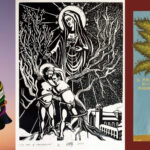

Kittredge, thank you for this article. I got here because I was chasing down illustrations of the story in Acts 8 for a Bible study I’m doing this week. I intend to include the portrait of Simeon Bachos with attribution to the artist and the source!
I was aware that the eunuch was held in esteem by LGBTQ+ folks and your article helps illuminate that further. Thank you and may the Spirit that gives life, inspiration, and strength bless you as you serve the One who loves us all.
Molly, thank you for your beautiful comment about the Ethiopian eunuch. I was hoping that the illustrations would lead interested people like you to my website and deeper understandings.
Edit*
Let me just start by stating that not only was the name NOT spelled that way prior to Greek translation but it originally doesn’t mean what you stated in his passage. It is spelled and pronounced “Henok” in Ethiopian and prior to recent English and greek SPELLING (not translation) it has been switched to Eunuch. For an example, The Ethiopian name Queen Sheba is “Saba” in Ethiopian, Aramaic and Hebrew but the name is NOT translated, just spelled differently. In the Ethiopian language Enoch means “Consecrated” or “Experienced” and the original name does not mean “Castrated” in Hebrew, Ethiopian or Aramaic, NOR was The man Enoch ever Castrated. The phrase “Eunuch” that Jesus used, also did not mean Castrated or of different/no sex. Please, Read to understand and not for purposes of attempting to add things where it seems fit, for you will lead many astray when it comes to understanding.
What an incredible attempt to justify homosexual behavior by twisting the meaning of words! The eunuch was not gay, he was a castrated male. It doesn’t take much research to find that this was a common act in those times in order to keep unwanted sexual acts from occurring between royalty, or individuals or a certain status, and others! It was also practiced among many early Christian bases faiths as well as pagan faiths in order to supposedly make abstinence easier to maintain. The eunuch wasn’t a minority….look at the area and mixes cultures it had. He wasn’t gay, he was castrated. He wasn’t an outsider, he was a government official(the queens treasurer and servant). The scripture you quoted in Matthew 19:12 tells of “those born thus from their mothers womb” which are sterile men, “whi were made by men” are castrated by owners or rulers, and “who have made themselves eunuchs” are those that did just that to honor their vow of celibacy. Just because you are leabian and desire to have a justification of your sinful lifestyle so as to be accepted and not convicted….doesn’t mean that your creative blasphemy of scripture is true! Get your facts straight, and then get your life straight with The Savior, and hopefully then get your lifestyle straight(which is an abomination to God BTW)
Thank you for all of these wonderful resources. I look forward to exploring ones I had not heard of before. You do such wonderful work. Thank you for the excellent posts!
The Ethiopian Eunuch was castrated against his will as a way to subjugate him to his authorities. The hope here is that even people who have had their gender desecrated can be openly welcomed into the faith. We can’t always undo our past until we are fully redeemed and restored in the age to come. Regardless of who we are, we are called to die to self and live for Jesus finding your identity in Him alone-not a group, or occupation, or economic status. We find forgiveness and sanctification as we trade our ways for His ways. He defines what is right regarding sexual relationships and activity-not our emotions or deep feelings or longings. This is for our good not for our harm. Whatever sin we find ourselves in we must turn from and this includes seeking happiness in homosexual or transgender activity even if there is emotional struggle or temptation that is hard to immediately overcome. Even if one feels it defines their state of being. I’m a heterosexual that struggles against the temptation of sexual heterosexual sin in my mind-Jesus said that is adultery. I’m not saying my sin is less than yours. I am recognizing that the battles in my mind are wrong and seeking repentance as Jesus has called me to do as a means of overcoming the sin in my heart. I’m not saying this in a hateful way either. Love calls out things that lead to destruction. I don’t want anyone to be deceived. God loves us and because of this even His rebuke is beautiful. I am not homophobic. I love you all. I know many of you in this community have gone through unimaginable pain. I pray that you can take that pain and use it as a ministry and commit as Paul did to suffer for the sake of the Gospel message and not your rights or affirmation of identity. This is something I’m learning to do as well. I have plenty of things to remove from my own life even if those things aren’t the same.
Philip used the prophecy of God’s rejected servant to tell the eunuch about Jesus as they traveled together in the chariot.
The meaning of the word “eunuch” (and its Koine-Greek equivalent in the original language) is well known and well-defined by people who actually used Koine-Greek in ancient times, despite attempts by some modern activists to redefine it: the word meant a castrated man, not a homosexual. And this article itself admits that the Ethiopian eunuch was a government official and hence not an “outcast” in any reasonable sense, nor would being black make him an outcast in the multi-racial Middle East where several races had blended for thousands of years (and historians are agreed that racial bias scarcely existed in the ancient Middle East), nor would any genuine status as an “outcast” (even if he was one) somehow justify the attempts to link this issue to support for sodomy.
Sorry, but I don’t accept this line of reasoning. Our use of “queer” and LGBTQ can’t possibly have the same implications, nor can be traced, to eunuchs in the ancient world. History has indicated that same sex relations occurred sometimes between a male citizen and a slave. But notions of identity politics didn’t exist then.
Philip welcomed the Ethiopian Eunuch, so the modern church should also welcome LGBT people, right? The problems with this argument should be obvious. There is a famous example of a Christian who reportedly castrated himself and that is Origen. Assuming that the story is true, Origen’s motive would have been to ensure that he remained chaste. Chastity was regarded as a virtue in the Church. However, this does not mean that Origen’s action was approved of; on the contrary, it was regarded as a scandal. So Origen’s self-emasculation does not offer a shred of support for those who undergo gender reassignment surgery. Self-emasculation was condemned even when the goal that it was designed to achieve was a respectable one. In the case of gender reassignment surgery, the goal and the means of achieving it are both unacceptable.
But this is all something of a digression. It is very probable that the Ethiopian Eunuch was castrated against his will. He was an innocent victim. If Origen fails to offer support for LGBT ideology, the Ethiopian Eunuch offers even less support.
You are quoting John J McNeill’s speculations. You need to remember two things: a/ the story is about an Ethiopian court official and b/ there is a record of the story in Ethiopian Orthodox church (in addition to the one in Acts 8). In other words, ignorance is no excuse for wild speculations! See if you can read this. Or get someone to translate it for you. ትውልዱ ከአክሱም ነው ስሙ ባኮስ ወይም አቤላክ ይባላል።በ1ኛው መ,ክ,ዘ, ከ34–46 ዓ,ም በኢትዮጵያ ላይ ነግሣ ለነበረቸው ለንግሥት ሕንደኬ ባለሟልና በገንዘቧ ላይ ሁሉ የሠለጠነ ሹሟ ስለነበረ መጽሐፍ ቅዱስ ጃንደረባ ይለዋል።እርግጥ ጃንደረባ የሚለው ቃል በተፈጥሮ ሕፅው (ስልብ)የሆኑ ወይም በሌላ ምክንያት እንዲያ የሆኑ ሰዎች የሚጠሩበት ቢሆንም መጽሐፍ ቅዱስ ግን ለባኮስ በሥልጣን ስምነቱ ቃሉን ተጠቅሞታል።
have read your article with great interest and I will be very happy to send you to complete your iconography, the second version of the Baptism of the Eunuch, 1631 by Rembrandt recently rediscovered based on two engravings: Johannes Gillis van Vliet’s print copy after Rembrandt 1631 (vertical format) and Claes Jansz Visscher 1632-33 (horizontal format)
Let me know if you are interested and how you would like me to send it to you in PDF.
Yes, I am definitely interested! I will send you an email with more details.
Thank you for this article. My church has a trans ministry (for support) and I will be using parts of your post for discussion.
The world is confused to day and misinterpreting LOVE.
Love is not a sexual behaviours like many people say that they are making love in the bed.
Love is GOD’s Spirit that unites people. Love makes someone care about others.
Love is not sexual desires.
Absolutely! It is this nameless man who makes the story so important to gay, lesbian, and bisexual Christians. So, let us look more closely at the identity of the Ethiopian eunuch. At the time of the writing of Acts, the term Ethiopian was used to describe people from Nubia, south of Egypt. So, we know from this description that he was probably a black African.
“Le Baptême de l’eunuque” (1718 by french painter Nicolas Bertin in St Germain des Prés church in Paris
‘Queering early christian discourse : the ethiopian eunuch”, Sean D. BURKE in Bible trouble : queer reading at the boundaries of biblical scholarship., Atlanta, Society of Biblical Literature, 2011, pp. 175-190.
The word for eunich in Acts 8:27 “eunouchos” refers to a person who has become a eunich to abstain from sexual relations so as to remain pure unto God, and this word is used in Matthew 19:12 for this purpose. Even if one does not take this view and says that the ethiopian man in Acts 8 was a homosexual, that does not mean homosexuality is not sin, and if he was a homosexual, he then turned from his sin in being saved as one has to completely put away (apotithemi) evil and receive The Word Of God implanted to be saved (James 1:21). God Is The Truth and Founds Truth (Aletheia) (which refers to Truth Of Idea or The Foundarion Of Reality Itself) As John 14:6 explains. this does not mean God is the world, but rather He Founds Truth and the existence of everything else that He Made (which is separate from Him and Held Together By Him) requires Him Being Who He Is As God (Colossians 1:16-17). therein His Word Is Truth and Judges (kritikos) the thoughts and intents of the heart. the word kritikos (,from krites, from krino) refers to separating or distinguishing. God’s Word Is Truth in order for a Viewpoint of error to even be able to exist as the lack of God. The First and Greatest Commandment Is to love The Lord your God with all of your heart, soul and mind (Matthew 22:36-38) and the second is to to love your neighbor as yourself (Matthew 22:39) and on these hang the entire law and everything written by the prophets (Matthew 22:40). Luke explains that this these two commandments (with strength included) is how one is saved and the love for the world (kosmon) which refers to the ordered system and includes all things made both people and things) means that God’s Love is not in you (1 John 2:15-16). The Holy Spirit Convicts the world concerning sin (hamartia) (missing the mark of God’s Perfect Love), righteousness (dikaiosuné) (what He Deems Right), and likewise The Judgement that will come against sin (John 16:8) where He Repays each person (Romans 12:19) and It Is His Word Which Will Judge (John 12:48).
As Romans 3:23 nasb States:
for all have sinned and fall short of the glory of God,
likewise, Romans 6:23 nasb States:
For the wages of sin is death, but the free gift of God is eternal life in Christ Jesus our Lord.
One needs to be believe in Jesus (pisteuo) (be persuaded and entrust to Him which comes from pistis (faith) which comes from peithó which means to be persuaded), and therein receive Him (John 1:12). as such, the belief of the eunich in Acts 8:37 mentioned by philip refers to the eunich being persuaded by God and choosing Him as opposed to anything else, including homosexuality if it applied. Making anything, (even the whole world) the purchase price of your soul besides God Who Is Love Who Extends Perfect Grace and Alone Is The Glory causes one to forfeit their soul (Mark 8:36-37) and this includes other people or anything in the world. Nothing in the world is worth having besides God Who Is The Glory, and Romans 1 addresses this issue directly in regards to all people who reverence the creation (Romans 1:28-30), but it also mentions specifically homosexuality of males and females. It explains that everyone knows The Invisible Qualities Of God (His Eternal Power and Divine Nature (Romans 1:20) and therein His Ordinance Of Righteousness (Romans 1:32), just by what has been Made. Those who do not honor Him As God though become futile in their speculations and their foolish hearts are darkened (Romans 1:21) and God’s Wrath is Revealed from heaven on those who suppress The Truth Of God in unrighteousness (Romans 1:18). Therein one who practices homosexuality along with any other sin (see Romans 1:28-31) comes from their desire to worship (sebazomai) (to reverence or stand in awe of) the creation (ktisis)(that which is Made, not just creatures), and also serve it rather than the creator (Romans 1:25) Who Founds Glory (doxa) (The Intrinsic Weight of Value) In Him. therein they no longer seem unworthy to have God in their minds and one of the things that people do therein is the worship of made idols, but the worship of anything but God is idolatry. check out Romans 1:23-27 nasb below, but it would be best to read the whole chapter as well.
24Therefore God gave them over in the lusts of their hearts to impurity, so that their bodies would be dishonored among them. 25For they exchanged the truth of God for a lie, and worshiped and served the creature rather than the Creator, who is blessed forever. Amen.
26For this reason God gave them over to degrading passions; for their women exchanged the natural function for that which is unnatural, 27and in the same way also the men abandoned the natural function of the woman and burned in their desire toward one another, men with men committing indecent acts and receiving in their own persons the due penalty of their error.
While The Wording is quite straight forward, God Is The One Who Reveals that The Scripture here is indeed in reference to homosexuality, and His Conviction causes a person to know it is wrong, as it is also explained throughout The Bible such as in 1 Corinthians 6:9, Leviticus 18:22 and 20:13. the reason it leads to death is because one is loving the creation instead of God Who Is The Glory Who Made the creation and is therein not performing the first commandment so as to do the second naturally since God Alone Is Love and even in the Old Testament the righteous man was to live by faith (Habakkuk 2:4) based upon belief as seen with Abraham (Galatians 3:6). Apart from Jesus no one can do anything (John 15:5) as when one is Saved By God and chooses Jesus, The Holy Spirit Seals their soul, (2 Corinthians 1:22) and then The Holy Spirit Fights Against The Flesh so that a believer would not do as they wish (Galatians 5:17).
God Is Perfectly Loving which is Why Jesus Paid for the sins of the world with His Own Blood and in so doing God Demonstrated His Own Love for us in that while we were still sinners, Christ died for us Romans 5:8). He Was pierced for our transgressions and crushed for our iniquities, the chastening for our wellbeing fell upon Him and By His Scourgong we are healed (Isaiah 53:5). this is because everyone has gone astray (Isaiah 53:6) and if God Were to count people’s iniquities, who could stand? (Psalm 130:4). there is nothing worth making the purchase price (antallagma) of one’s soul in the world as Mark 8:37 explains. God Alone Is The Life, and if one does not choose Jesus (The Son) their sins will not be paid for since He Became The Sin Offering (Romans 8:3) and they will likewise not have Life as 1 John 5:12 nasb states below:
He who has the Son has the life; he who does not have the Son of God does not have the life.
As such i urge everyone who is unsaved to be reconciled to God and receive Life In Him Who Is The Life and Founds Truth Itself In Him (John 14:6). for those who are are running from Him Who Is Perfect Love His Grace (charis) (The Lord’s Favor Extended) is freely offered to everyone (Romans 11:6; John 1:16).
Obviously I disagree, because your interpretation is completely different from what I wrote in my original article. I am approving your overly long comment so people can see the need to keep on affirming God’s love for LGBTQ people. Scripture does not condemn loving, responsible homosexual relationships. There are many resources that fully explain the Bible and homosexuality. Here are a few that I recommend:
Theological resources from Metropolitan Community Churches
“What the Bible Really Says about Homosexuality” by Daniel Helminiak
“Radical Love: Introduction to Queer Theology” by Patrick Cheng
gaychurch.org
The Bible and Gays by Rev. Durrell Watkins
Kittredge,
I wrote what i did because God Is Love (1 John 4:8), and as 1 Timothy 2:4 explains, He Wants all people to be saved and come to a knowledge of The Truth. He loves homosexuals perfectly, which is why Jesus died to pay for their sins with His Own Blood (Hebrews 9:12), but a person has to repent and turn to The Lord to have their sins wiped away (Acts 3:19). Do you confess that Jesus Christ Has Come in the flesh?
Besides Romans 1:18-32 check out the other verses I mentioned in there, (Leviticus 18:22, 20:13 and 1 Corinthians 6:9) along with 1 Timothy 1:10 and Genesis 19:4-7 which I did not mention,
It should be remembered that In Matthew 5:17-18 nash it is written that Jesus Stated:
“Do not think that I came to abolish the Law or the Prophets; I did not come to abolish but to fulfill. 18“For truly I say to you, until heaven and earth pass away, not the smallest letter or stroke shall pass from the Law until all is accomplished.
The entire Law and the prophets hinge likewise on the first and second commandment (Matthew 22:36-40).
In regards to all God’s Commandments, 1 John 2:4 nasb States:
“The one who says, “I have come to know Him,” and does not keep His commandments, is a liar, and the truth is not in him;”
-God Loves you Kittredge,
-Noah
I also meant to say, “no longer deem it worthy to have God in their minds” rather than “no longer seem unworthy to have God in their minds” which is what i wrote by accident.
The author of this article misspeaks when they say: “Jesus himself used eunuch as an ancient term for LGBTQ people when he declared in Matthew 19:12: ‘There are eunuchs who were born that way.’ The traditional interpretation of this scripture is that Jesus was speaking of voluntary celibacy.”
This is not true and Jesus did no such thing. There were three kinds of eunuchs known in the ancient world and Jesus mentions all three. According to Jesus in Matthew 19:12, there were:
(1) Eunuchs who were born that way: i.e., those born with some physical imperfection or deformity, such as undescended testicles.
(2) Eunuchs who were made eunuchs by men: i.e., those who were castrated to serve in royal places or priests who served in temples.
(3) Eunuchs who made themselves eunuchs for the sake of the kingdom of heaven: i.e., those who willingly renounced marriage as a free choice for purposes of ministry or to better serving the Kingdom.
So where then does the author get the false notion that “Jesus himself used eunuch as an ancient term for LGBTQ people?” On what biblical foundation do they (or anyone else for that matter) base that on? It is simply not there.
Why does the article label the Ethiopian Eunuch as non-Jew?
Most assume that he must have been a Gentile because he was Ethiopian, but he could have been a Jewish convert. I will add this line to my article.
How does someone who had his penis cut off by force be equated to homos and faggs of today ?